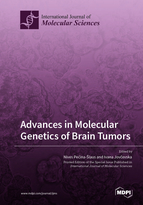Advances in Molecular Genetics of Brain Tumors
A special issue of International Journal of Molecular Sciences (ISSN 1422-0067). This special issue belongs to the section "Molecular Oncology".
Deadline for manuscript submissions: closed (30 April 2022) | Viewed by 38220
Special Issue Editors
Interests: cancer genetics; brain tumors; Wnt signaling pathway; epithelial-to-mesenchymal transition; genomic instability; biomarkers
Interests: glioblastoma; nanobodies; nanomedicine; proteomics; oncology; oncogenesis; genetics; transcriptomics
Special Issue Information
Dear colleagues,
we understand nowadays that cancer is not a single disease but rather a collection of diseases with specific genetic profiles. Genetic landscapes of cancer are formidable because they include malfunctioning of genes involved in a variety of vital cellular processes, including cell growth, proliferation, differentiation, apoptosis, mechanisms of DNA repair, cell mobility, angiogenesis, immune system. Therefore the field of cancer genomics is fast expanding and accumulating knowledge in order to develop novel and efficient therapeutic approaches. Brain tumors display a broad spectrum of clinical, histological and genetic features. The majority of brain tumors are unfortunately showing poor prognosis and survival. Taking into account the great heterogeneity of different brain tumor types and tumor cells even within the specific subtype, it is important to understand that their biology is still largely unexplained. It has long been known that cellular signaling networks interact and communicate and the malfunctioning of these interactions govern the brain tumorigenesis often preserving neoplastic cell phenotype.
The Special Issue intents to elucidate the diversity of problems and solutions behind brain tumors. The topics will cover events - molecular genetics, signaling pathways governing the mechanisms of tumor formation and invasion, DNA methylation, predictive biomarkers, diagnostic improvement, potential therapeutic targets, metastasis and recurrence, but also the difference in therapeutic response of specific clinical subtypes. Studies that bring results of large-scale analyses and system biology are also welcome. Besides the known driver genes and their mutations, some of which have already been comprehensively characterized, the investigation of genes harboring passenger mutations that are less known molecular players and probably contribute to tumor heterogeneity will also be one of the focuses of the issue.
The issue welcomes original work unraveling novel innovative studies on the genetics of brain tumors, but also reviews with a perspective points of view and interesting cases that can shed light on novel genetic events.
Prof. Nives Pećina‐Šlaus
Dr. Ivana Jovčevska
Guest Editors
Manuscript Submission Information
Manuscripts should be submitted online at www.mdpi.com by registering and logging in to this website. Once you are registered, click here to go to the submission form. Manuscripts can be submitted until the deadline. All submissions that pass pre-check are peer-reviewed. Accepted papers will be published continuously in the journal (as soon as accepted) and will be listed together on the special issue website. Research articles, review articles as well as short communications are invited. For planned papers, a title and short abstract (about 100 words) can be sent to the Editorial Office for announcement on this website.
Submitted manuscripts should not have been published previously, nor be under consideration for publication elsewhere (except conference proceedings papers). All manuscripts are thoroughly refereed through a single-blind peer-review process. A guide for authors and other relevant information for submission of manuscripts is available on the Instructions for Authors page. International Journal of Molecular Sciences is an international peer-reviewed open access semimonthly journal published by MDPI.
Please visit the Instructions for Authors page before submitting a manuscript. There is an Article Processing Charge (APC) for publication in this open access journal. For details about the APC please see here. Submitted papers should be well formatted and use good English. Authors may use MDPI's English editing service prior to publication or during author revisions.
Keywords
- Brain tumors
- Cellular signaling pathways
- Tumor formation and invasion
- Molecular genetics
- Diagnostic and therapeutic biomarkers
- Metastasis and recurrence
- Epithelial-to-mesenchymal transition
- Response to therapy
- Large scale analysis
- System biology
- DNA Methylation








